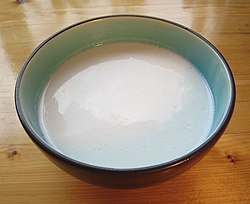
Back Klappermelk AF حليب جوز هند Arabic নাৰিকলৰ গাখীৰ AS Lleche de cocu AST Guta BCL Какосавае малако BE Santen BEW Кокосово мляко Bulgarian নারকেল দুধ Bengali/Bangla Llet de coco Catalan
 | |
| Region or state | Traditional: Southeast Asia, Oceania, South Asia, East Africa Introduced: Caribbean, Central America, northern parts of South America, West Africa |
|---|---|
| Main ingredients | Coconut |
Coconut milk is an opaque, milky-white liquid extracted from the grated pulp of mature coconuts.[1][2] The opacity and rich taste of coconut milk are due to its high oil content, most of which is saturated fat. Coconut milk is a traditional food ingredient used in Southeast Asia, Oceania, South Asia, and East Africa. It is also used for cooking in the Caribbean, Central America, northern parts of South America and West Africa, where coconuts were introduced during the colonial era.
Coconut milk is differentiated into subtypes based on fat content. They can be generalized into coconut cream (or thick coconut milk) with the highest amount of fat; coconut milk (or thin coconut milk) with a maximum of around 20% fat; and coconut skim milk with negligible amounts of fat.[3][4] This terminology is not always followed in commercial coconut milk sold in Western countries.[5]
Coconut milk can also be used to produce milk substitutes (differentiated as "coconut milk beverages"). These products are not the same as regular coconut milk products which are meant for cooking, not drinking.[6] A sweetened, processed, coconut milk product from Puerto Rico is also known as cream of coconut. It is used in many desserts and beverages like the piña colada, though it should not be confused with coconut cream.[5][7]
- ^ "Coconut milk" (PDF). Philippine Coconut Authority. 2014. Archived from the original (PDF) on 6 November 2020. Retrieved 22 September 2016.
- ^ Tulashie, Samuel Kofi; Amenakpor, Jacking; Atisey, Sandra; Odai, Raphael; Akpari, Ephraim Edem Amoah (2022). "Production of coconut milk: A sustainable alternative plant-based milk". Case Studies in Chemical and Environmental Engineering. 6: 100206. Bibcode:2022CSCEE...600206T. doi:10.1016/j.cscee.2022.100206.
- ^ NIIR Board of Consultants and Engineers (2006). The Complete Book on Coconut & Coconut Products (Cultivation and Processing). Asia Pacific Business Press Inc. p. 274. ISBN 978-81-7833-007-5.
- ^ Tetra Pak (2016). "The Chemistry of Coconut Milk and Cream". Coconut Handbook. Tetra Pak International S.A. ISBN 978-91-7773-948-7.
- ^ a b Lewis, Susana; Lewis, Charles (2012). A Taste of Paradise. Psy Press. p. 18. ISBN 978-1-938318-00-9.
- ^ Cite error: The named reference
bridgeswas invoked but never defined (see the help page). - ^ "Coconut milk, cream, and sweetened cream". ochef.com. Archived from the original on 5 March 2016.